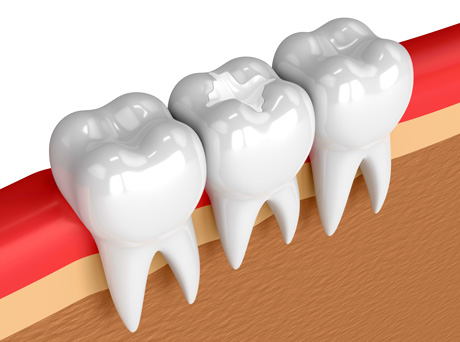 Dental fillings can be cosmetic, but their primary purpose is to restore a tooth damaged by decay or fracture back to its normal shape and function. The filling repairs the tooth and stops the decay. We primarily use composite resin (tooth-colored) filling material. Amalgam (silver) is a mixture of mercury, silver, tin or other metals, and can also be used as a less expensive option.
Dental fillings can be cosmetic, but their primary purpose is to restore a tooth damaged by decay or fracture back to its normal shape and function. The filling repairs the tooth and stops the decay. We primarily use composite resin (tooth-colored) filling material. Amalgam (silver) is a mixture of mercury, silver, tin or other metals, and can also be used as a less expensive option.
Procedure
Dr. Fernandez or Dr. Cox numbs the area so you don’t feel a thing. The dentist uses a handpiece to remove decay and shape the tooth.
A thin flexible band is placed around the tooth which will help mold the filling into the shape of the tooth. A small wedge may also be used to hold the band snugly in place.
Composite Resin Fillings
A mild solution is placed on the tooth to chemically etch it. This will provide for a strong bond between the resin and the tooth. Dr. Fernandez or Dr. Cox then carefully places the resin into the prepared tooth, layer by layer. A purple curing light is used to harden each layer. The final contours of the filling are shaped and the bite is checked. Finally, the tooth is polished.
The Benefits of Resin Fillings
The seal created by a resin filling is very strong because it bonds directly to the tooth. The material is also durable and provides good protection for your tooth. Because we are able to match the resin filling material to the color of your natural teeth, composite resin fillings are a great choice to restore your teeth and enhance your natural smile.
Amalgam Fillings
Once the tooth is prepared, Dr. Fernandez or Dr. Cox presses the silver amalgam filling material into the tooth and then carves it into the proper shape. Finally, the fit and bite are checked and adjusted as necessary.
The Benefits of Amalgam Fillings
Amalgam fillings are very strong and durable and can withstand heavy biting forces. An amalgam filling seals out bacteria and protects the tooth. They are a good choice for restoring tooth function.
Post-Procedure Care
After the procedure you may still be numb for a few hours until the numbing medicine wears off. Please be careful not to chew on your lip or cheek when it is still numb and refrain from eating until the numbness has worn off.
Your tooth may be sensitive after a filling. If you are experiencing continued pain after the numbness wears off, contact our office. Your filling may be too high. This is not uncommon but requires that we see you to adjust the bite. Other tooth sensitivity should subside within one to two weeks. Until then, try to avoid whatever is causing your tooth to be sensitive. If sensitivity continues longer than two weeks, contact our office as we will want to see you.

